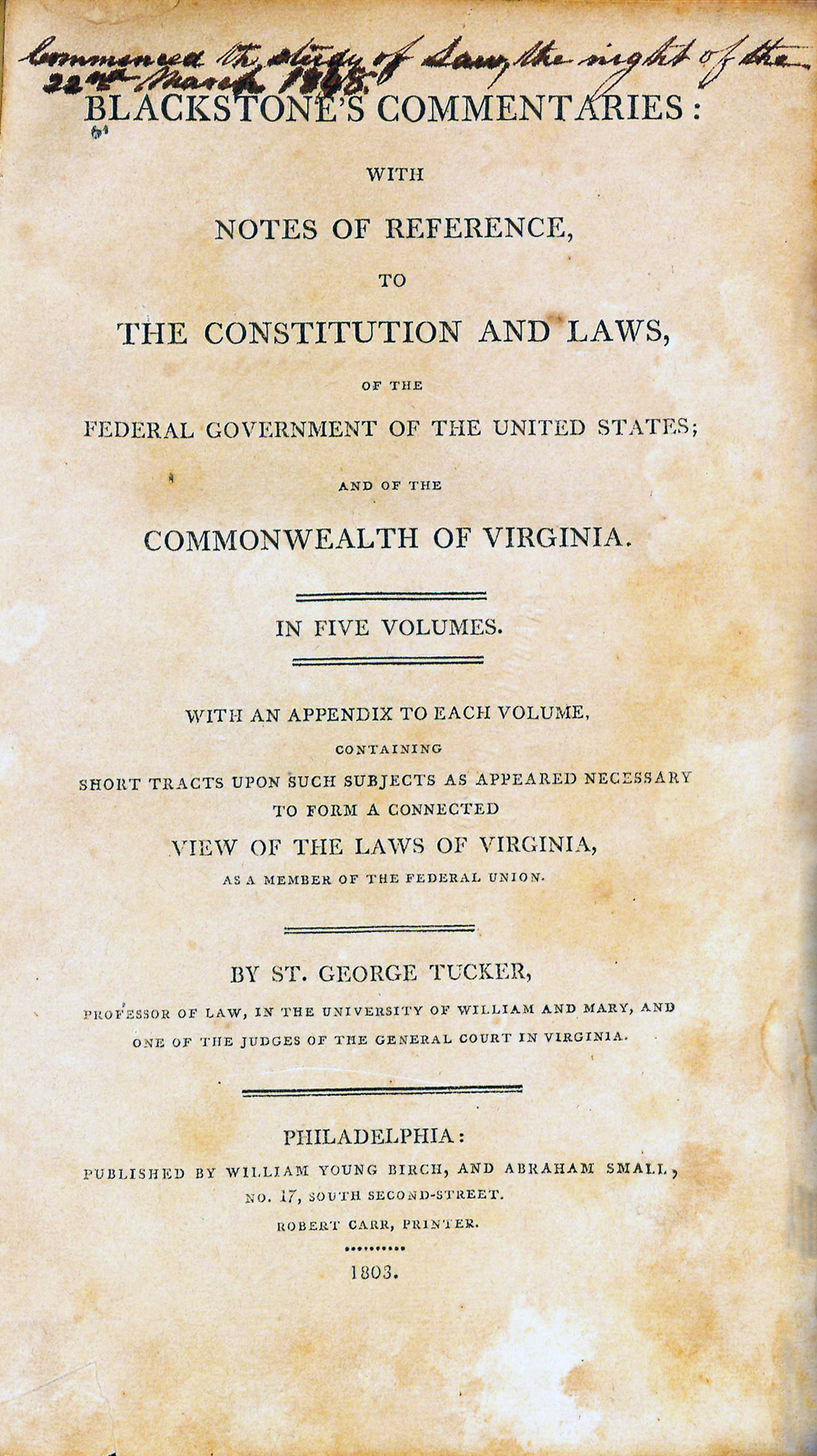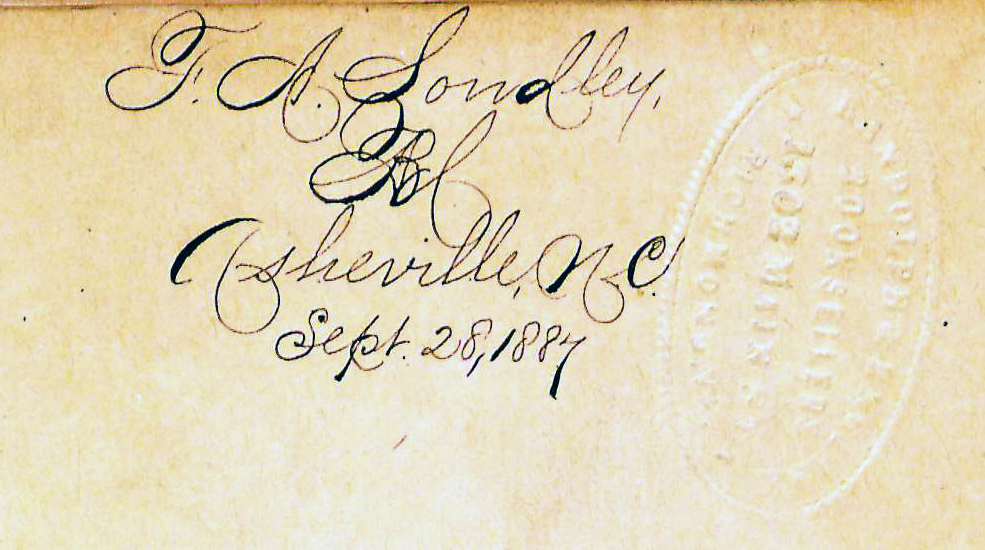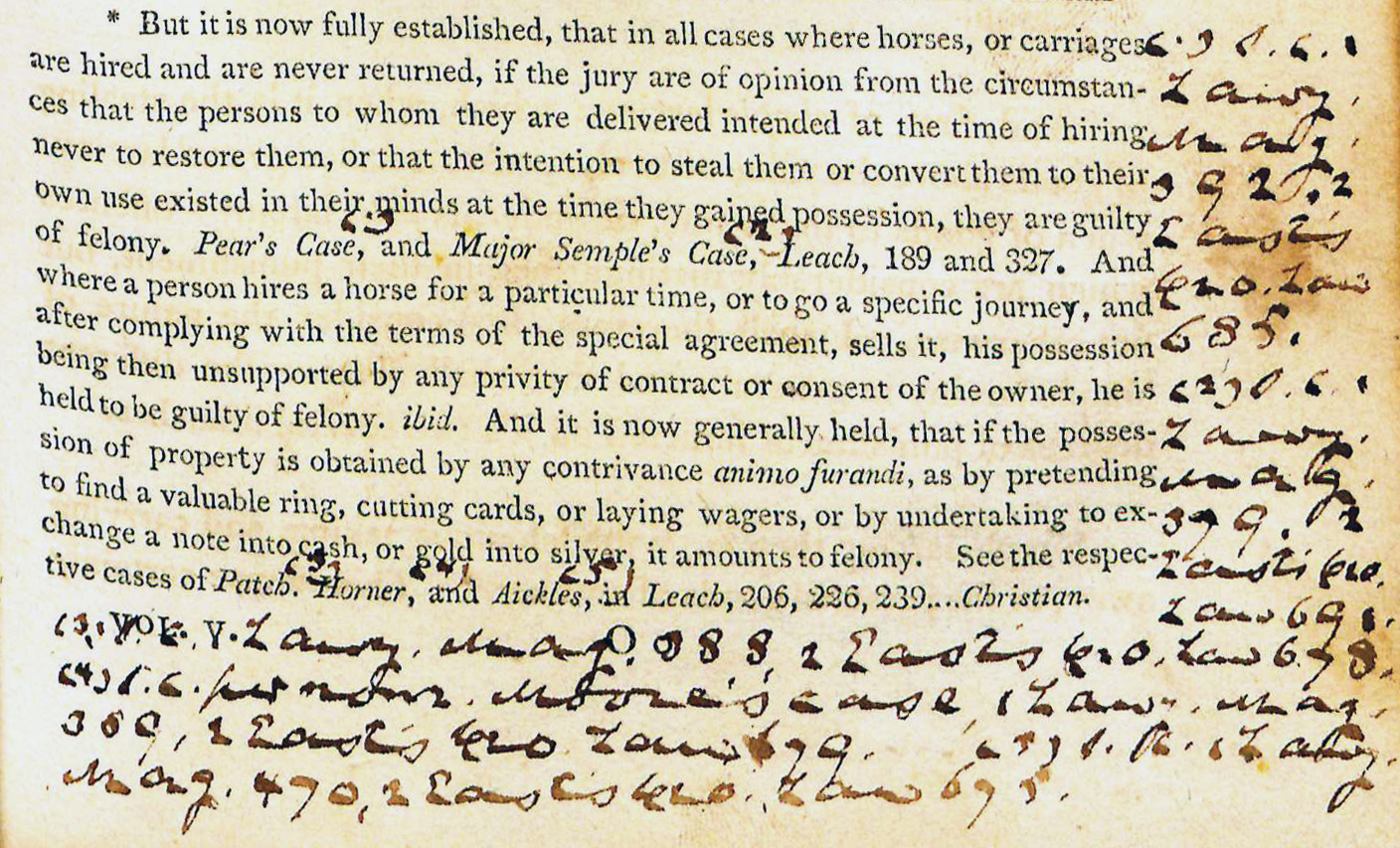Blackstone's Commentaries
Blackstone's Commentaries: with Notes of Reference, to the Constitution and Laws, of the Federal Government of the United States; and of the Commonwealth of Virginia. In Five Volumes with an Appendix to Each Volume, Containing Short Tracts upon Such Subjects as Appeared Necessary to Form a Connected view of the Laws of Virginia, as a Member of the Federal Union
by St. George Tucker
| Blackstone's Commentaries | |
|
Title page from Blackstone's Commentaries, volume one, George Wythe Collection, Wolf Law Library, College of William & Mary. | |
| Author | William Blackstone |
| Published | Philadelphia: Published by William Young Birch, and Abraham Small, no. 17, South Second-street, Robert Carr, printer |
| Date | 1803 |
| Language | English |
| Volumes | 4 volumes in 5 volume set |
| Desc. | 8vo (22 cm.) |
In 1795, at the urging of several friends, including former Virginia governor John Page, Tucker began investigating the possibility of publishing his written works, including an edition of Blackstone with his notes and with his lectures from William & Mary added as appendixes.[6] After a couple of unsuccessful attempts to find a printer, Tucker reached an agreement with the Philadelphia firm of Birch and Small, which paid Tucker $4000 for the book's copyright.[7] "Tucker's Blackstone" was organized into five volumes. Each volume would begin with Blackstone's original text, with notes from Tucker added, followed by an appendix containing Tucker's lectures and writings on particular subjects.[8] Blackstone's text was mostly arranged the same way as in the original version, but Tucker organized the appendixes to show what he felt the most important developments in American law were.[9]
Tucker's Blackstone sold well from the beginning,[10] and it quickly became the major treatise on American law in the early 19th century.[11] Law reporter Daniel Call described it as "necessary to every student and practitioner of law in Virginia".[12] Lawyers arguing before the Supreme Court of the United States would frequently cite to Tucker's Blackstone - more often than any other commentator until 1827.[13] The U.S. Supreme Court itself cited Tucker's Blackstone frequently, referring to it in over forty cases, many of them significant.[14] Modern lawyers, legal scholars, and judges still refer to this work as an important tool for determining how Americans understood both English and American law in the early days after the United States's independence.[15]
Evidence for Inclusion in Wythe's Library
Listed in the Jefferson Inventory of Wythe's Library as "Tucker’s Blackstone 5.v. 8vo." and given by Thomas Jefferson to his son-in-law, Thomas Mann Randolph. Later appears on Randolph's 1832 estate inventory as "Tucker's Blackstone (3 odd vols.)' (3 vols., $3.00 value)." Both George Wythe's Library[16] on LibraryThing and the Brown Bibliography[17] include Tucker's Blackstone. The Wolf Law Library purchased a copy of the first edition.
Description of The Wolf Law Library's Copy
Bound in contemporary calf and rebacked in matching period style, retaining the original red and black morocco gilt-lettered spine labels. Gilt ruling decorates the spine. Contains marginalia throughout the volumes. Each front free endpaper has the signature of the well-known North Carolina author, lawyer, and historian "F.A. Sondley, Asheville, N.C., Sept. 28, 1887" and the embossed stamp of "Randolph & English, Booksellers, 1502 Main St., Richmond VA." Most volumes signed "Wm. Green, 1834" on a preliminary page; volume three signed "William Green, 1834." Volume three also signed "John W. Green" on the title page. The upper margin of the first volume's title page states, "Commenced the study of Law, the night of the 22nd March 1848." Purchased from David Lesser.
View this book in William & Mary's online catalog.
References
- ↑ Paul Finkelman and David Cobin, "An Introduction to St. George Tucker's Blackstone's Commentaries," in St. George Tucker, Blackstone's Commentaries (1803; repr., Union, N.J.: Lawbook Exchange, 1996), 1:x.
- ↑ Finkelman and Cobin, "Introduction to Tucker's Blackstone," 1:x.
- ↑ Finkelman and Cobin, "Introduction to Tucker's Blackstone," 1:i.
- ↑ Davison M. Douglas,"Foreword: The Legacy of St. George Tucker," 47 William and Mary Law Review (2006), 1113.
- ↑ Charles T. Cullen, St. George Tucker and Law in Virginia, 1772-1804 (New York: Garland Publishing, 1987), 121,123-126.
- ↑ Cullen, "St. George Tucker and Law in Virginia," 157.
- ↑ Cullen, "St. George Tucker and Law in Virginia," 157-160.
- ↑ Cullen, "St. George Tucker and Law in Virginia," 161.
- ↑ Cullen, "St. George Tucker and Law in Virginia," 161.
- ↑ Cullen, "St. George Tucker and Law in Virginia," 160-161.
- ↑ Douglas, "Legacy of St. George Tucker," 1114.
- ↑ 8 Va. (4 Call) xxviii (1833)
- ↑ Cullen, "St. George Tucker and Law in Virginia," 162-163.
- ↑ Finkelman and Cobin, "Introduction to Tucker's Blackstone," 1:v-vi.
- ↑ Finkelman and Cobin, "Introduction to Tucker's Blackstone," 1:i-ii, v-vi.
- ↑ LibraryThing, s. v."Member: George Wythe," accessed on November 18, 2013.
- ↑ Bennie Brown, "The Library of George Wythe of Williamsburg and Richmond," (unpublished manuscript, May, 2012) Microsoft Word file. Earlier edition available at: https://digitalarchive.wm.edu/handle/10288/13433



